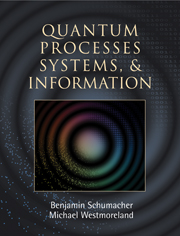Book contents
- Frontmatter
- Contents
- Preface
- 1 Bits and quanta
- 2 Qubits
- 3 States and observables
- 4 Distinguishability and information
- 5 Quantum dynamics
- 6 Entanglement
- 7 Information and ebits
- 8 Density operators
- 9 Open systems
- 10 A particle in space
- 11 Dynamics of a free particle
- 12 Spin and rotation
- 13 Ladder systems
- 14 Many particles
- 15 Stationary states in 1-D
- 16 Bound states in 3-D
- 17 Perturbation theory
- 18 Quantum information processing
- 19 Classical and quantum entropy
- 20 Error correction
- Appendix A Probability
- Appendix B Fourier facts
- Appendix C Gaussian functions
- Appendix D Generalized evolution
- Index
1 - Bits and quanta
Published online by Cambridge University Press: 05 June 2012
- Frontmatter
- Contents
- Preface
- 1 Bits and quanta
- 2 Qubits
- 3 States and observables
- 4 Distinguishability and information
- 5 Quantum dynamics
- 6 Entanglement
- 7 Information and ebits
- 8 Density operators
- 9 Open systems
- 10 A particle in space
- 11 Dynamics of a free particle
- 12 Spin and rotation
- 13 Ladder systems
- 14 Many particles
- 15 Stationary states in 1-D
- 16 Bound states in 3-D
- 17 Perturbation theory
- 18 Quantum information processing
- 19 Classical and quantum entropy
- 20 Error correction
- Appendix A Probability
- Appendix B Fourier facts
- Appendix C Gaussian functions
- Appendix D Generalized evolution
- Index
Summary
Information and bits
On the evening of 18 April 1775, British troops garrisoned in Boston prepared to move west to the towns of Lexington and Concord to seize the weapons and capture the leaders of the rebellious American colonists. The colonists had anticipated such a move and prepared for it. However, there were two possible routes by which the British might leave the city: by land via Boston Neck, or directly across the water of Boston Harbor. The colonists had established a system of spies and couriers to carry the word ahead of the advancing troops, informing the colonial militias exactly when, and by what road, the British were coming.
The vital message was delivered first by signal lamps hung in the steeple of Christ Church in Boston and observed by watchers over the harbor in Charlestown. As Henry Wadsworth Longfellow later wrote,
One if by land, and two if by sea;
And I on the opposite shore will be,
Ready to ride and spread the alarm
Through every Middlesex village and farm …
Two lamps: the British were crossing the harbor. A silversmith named Paul Revere, who had helped to organize the communication network, was dispatched on horseback to carry the news to Lexington. He stopped at houses all along the way and called out the local militia. By dawn on 19 April, the militiamen were facing the British on Lexington Common.
- Type
- Chapter
- Information
- Quantum Processes Systems, and Information , pp. 1 - 14Publisher: Cambridge University PressPrint publication year: 2010



